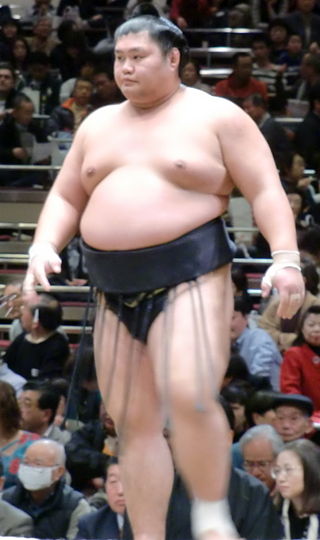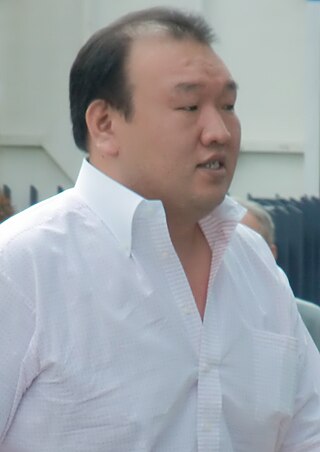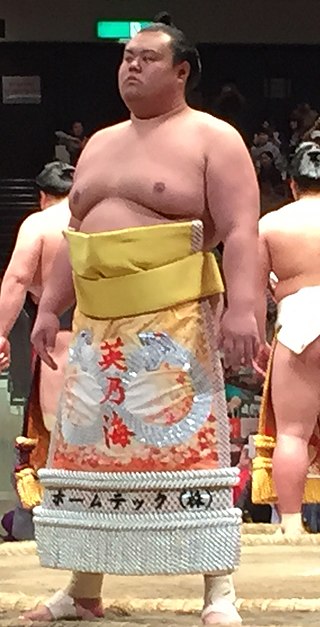Related Research Articles
Buyūzan Takeyoshi is a former sumo wrestler. His highest rank was maegashira 1. He is now a sumo coach.

Tosanoumi Toshio, is a former sumo wrestler. He first reached the top division of professional sumo in 1995, winning 13 special prizes and earning 11 kinboshi or gold stars for defeating yokozuna over his long career. The highest rank he reached was sekiwake. He retired in 2010 to become a coach at his stable, Isenoumi stable under the name of Tatekawa.

Satoyama Kōsaku is a retired professional sumo wrestler from Ōshima, Kagoshima Prefecture, Japan. A former amateur sumo champion at Nihon University, he entered professional sumo in 2004 and first reached the top makuuchi division in 2007. His highest rank was maegashira 12. He spent much of his career in the jūryō and makushita divisions, and won a yusho or tournament championship in each. He won promotion back to the top division in 2014 after a seven-year and 37-tournament absence, the longest ever. He was a member of Onoe stable. He retired in November 2018 and is an elder of the Japan Sumo Association under the name of Chiganoura.

Yamahibiki stable is a stable of sumo wrestlers, part of the Dewanoumi ichimon or group of stables. It was set up in 1985 as Kitanoumi stable by former yokozuna Kitanoumi, who branched off from Mihogaseki stable. It absorbed Hatachiyama stable in 2006, following the death of its head coach, former ōzeki Hokuten'yū. In May 2010 it also absorbed Kise stable, which was forced to close after its stablemaster, former maegashira Higonoumi, was implicated in the selling of tournament tickets to yakuza members. As a result of this move the stable had 46 wrestlers, making it by some margin the largest stable in sumo at this time. It was the first stable to have over 40 wrestlers since Futagoyama stable in 1998, and had difficulty in finding room for so many. As a result, Kise was allowed to reestablish the stable in April 2012, and all former members of Kise stable, as well as newcomers Jōkōryū and Sasanoyama who had been recruited by Kise-oyakata, joined the reconstituted stable again.

Kise stable is a stable of sumo wrestlers, part of the Dewanoumi ichimon or group of stables. It was established in its current form in December 2003 by former maegashira and Nihon University amateur champion Higonoumi, who branched off from Mihogaseki stable. The stable's first top division wrestler was Kiyoseumi in January 2008. Its foreign recruit, Georgian Gagamaru, in May 2010 earned promotion to the top division. It is a popular destination for wrestlers with collegiate sumo experience like its stablemaster.
The following are the events in professional sumo during 2009.
The following are the events in professional sumo during 2003.
Ōzutsu Takeshi is a former sumo wrestler from Mie, Japan. Beginning his professional career in May 1971, he was ranked in the top makuuchi division continuously from March 1979 to January 1992, and his record of 1170 consecutive bouts there is the second best in history after Takamiyama. His highest rank was sekiwake. He was runner-up in one tournament and earned ten kinboshi or gold stars for defeating yokozuna. He also won four sanshō or special prizes. He wrestled for Taihō stable and after his retirement in May 1992 he worked there as a coach before leaving the Japan Sumo Association in 2008.

Kitataiki Akeyoshi is a former professional sumo wrestler from Machida City, Tokyo, Japan. Making his debut in March 1998, he reached the top division for the first time in September 2008, returning in January 2010. He won two second division jūryō championships in his career. His highest rank was maegashira 2. He retired in January 2018 and became an elder of the Japan Sumo Association under the name of Onogawa.
The following are the events in professional sumo during 2010.
Hamanoshima Keishi is a former sumo wrestler from Uto, Kumamoto Prefecture, Japan. A former amateur champion, he turned professional in 1992, reaching the top makuuchi division in 1994. His highest rank was komusubi. After his retirement from active competition in 2004 he became an elder of the Japan Sumo Association and founded Onoe stable in 2006, which has produced a number of top division wrestlers.

Gagamaru Masaru is a Georgian former professional sumo wrestler from Tbilisi. The third Georgian national after Kokkai and Tochinoshin to make the top makuuchi division, he made his professional debut in November 2005, reaching the jūryō division in November 2009 and makuuchi in July 2010. Originally from Kise stable, he briefly competed for the Kitanoumi stable before moving back to the Kise stable after it was re-established. His highest rank was komusubi. He won two special prizes for Fighting Spirit and was runner-up in one top division tournament. After missing nearly all of 2020 through injury and falling greatly in rank, he announced his retirement during the November 2020 tournament.

Wakakōyū Masaya is a former professional sumo wrestler from Funabashi, Japan. His highest rank was komusubi. The last two characters of his ring name were taken from his mentor and coach at Ōnomatsu, the former Masurao. He was only the second wrestler from his stable to reach the top division. He was runner-up in one tournament and earned one special prize, for Fighting Spirit. He is now a sumo coach.
The following are the events in professional sumo during 2012.

Jōkōryū Takayuki is a Japanese former professional sumo wrestler. He made his professional debut in 2011 after a successful college career in sumo. He currently holds the record for the most consecutive wins since entering professional sumo, with 27, and for the fastest rise to the top makuuchi division from the lowest jonokuchi division. His highest was komusubi, which he reached in September 2014. However, because of injuries he fell down the rankings, reaching a low of sandanme 23 in November 2016. He returned to the jūryō division for four tournaments from November 2020 until May 2021, but announced his retirement in September 2022 having fallen to the makushita division.

Ganyū Kenji is a former sumo wrestler from Himeji, Hyōgo, Japan. He made his professional debut in March 1986, and reached the top division in March 1996. His highest rank was maegashira 1. He retired in 2000 and became an elder of the Japan Sumo Association. In 2015 he became the head coach of Yamahibiki stable following the death of his old stablemaster, Kitanoumi.
Hachiya Toshiyuki (蜂矢敏行) was a sumo wrestler from Motosu, Gifu, Japan. He made his professional debut in September 1968. He holds the record jointly with Oshio for the most tournaments fought in the juryo division, at 55. He spent four tournaments in the top makuuchi division, peaking at maegashira 6 in November 1984. At around 108 kg (238 lb) he was one of the lightest sekitori. He retired in 1987 and became an elder of the Japan Sumo Association under the name Onogawa until his death in 2001.

Tokushōryū Makoto is a Japanese former professional sumo wrestler from Nara. An amateur sumo competitor while studying at Kinki University, he joined Kise stable and made his professional debut in January 2009. He won championships in the jonokuchi, sandanme and jūryō divisions, and first reached the top makuuchi division in July 2013. After spending most of 2018 and 2019 in the second tier, Tokushōryū returned to makuuchi in January 2020 and recorded 14 wins to take an upset top-division championship victory at the age of 33. He retired from competition in September 2023 and is now coaching at Kise stable as an elder. His highest rank was maegashira 2, and he earned one kinboshi and two special prizes in his career.

Hidenoumi Takuya is a Japanese professional sumo wrestler for Kise stable. A former amateur sumo competitor at Nihon University, he made his professional debut in 2012 and was promoted to the top makuuchi division in July 2015. His highest rank to date is maegashira 6. He has one jūryō division yūshō or championship. He is the elder brother of Oitekaze stable wrestler Tobizaru.
Akiseyama Mitsuhiko is a former Japanese professional sumo wrestler from Kasugai, Aichi. An amateur sumo competitor while studying at Nihon University, he made his professional debut in January 2008. He has two lower-division championships in jonokuchi and makushita, and reached the top makuuchi division in March 2016. His highest rank was maegashira 12. He wrestled for Kise stable, where he now coaches under the name of Izutsu.
References
- ↑ "Sumo association punishes coaches over distribution of tournament seats to yakuza". Mainichi Daily News. 27 May 2010. Archived from the original on 30 May 2010. Retrieved 8 June 2010.
- ↑ "Kise wrestlers to join Kitanoumi stable". Japan Times. 30 May 2010. Retrieved 8 June 2010.
- ↑ "Sumo coach Kise reveals having ties with member of crime syndicate". Canadian Press/AP. Archived from the original on 17 June 2010. Retrieved 15 June 2010.
- ↑ "Wins of Higonoumi". Sumo Reference. Retrieved 13 August 2010.
- ↑ "Higonoumi Naoya Rikishi Information". Sumo Reference. Retrieved 18 September 2012.